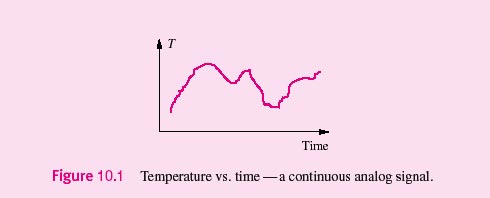
(See related pages)
In Part II, we explored the analysis and design of circuits used to manipulate information in discrete form—that is, binary data. However, much information about the world around us, such as temperature, humidity, pressure, velocity, light intensity, sound, and so on, is “analog” in nature, may take on any value within some continuous range, and can be represented by the analog signal in Fig. 10.1. In electrical form, these signals may be the output of transducers that measure pressure, temperature, or flow rate, or the audio signal from a microphone or stereo amplifier. The characteristics of these signals are most often manipulated using linear amplifiers, which change the amplitude and/or phase of a signal without affecting its spectral content.
Invention of the Audion tube by Lee DeForest in 1906 was a milestone event in electronics as it represented the first device that provided amplification with reasonable isolation between the input and output [1, 2, 3]. Amplifiers today, most often in solid-state form, play a key role in the multitude of electronic devices that we encounter in our daily activities, even in devices that we often think are digital in nature. Examples include cell phones, disk drives, digital audio and DVD players, and global positioning systems. Although we usually consider many of these to be digital in nature, in fact all these devices utilize amplifiers to transform very small analog signals to levels where they can be reliably converted into digital form. Analog circuit technology also lies at the heart of the interface between the analog and digital portions of these devices in the form of analog-to-digital (A/D) and digital-to-analog (D/A) converters. Every day the world is becoming connected through an increasing variety of communications links. Optical fiber systems, cable modems, digital subscriber lines, and wireless communications technologies rely on amplifiers to both generate and then detect extremely small signals containing the transmitted information. Part III of this text explores the design of amplifiers that are required in all these applications. Most of these devices mentioned in the previous paragraph employ “mixed signal” designs that require a knowledge of both analog and digital circuitry as well as the A/D and D/A conversion interfaces between the two. |
